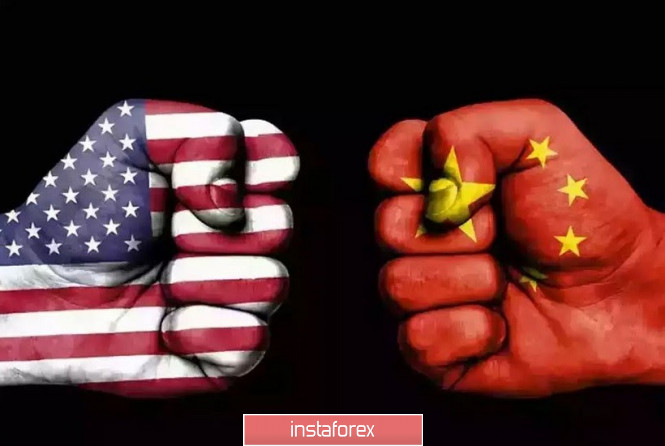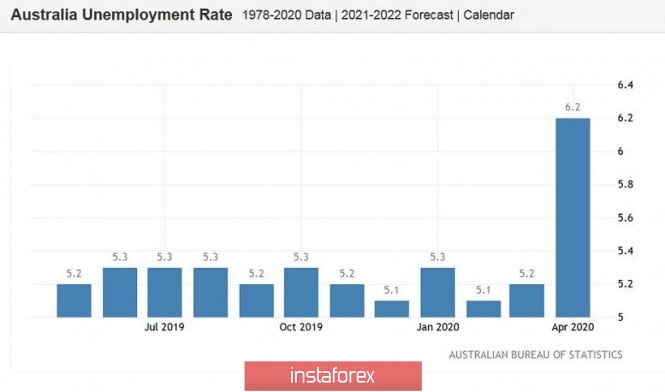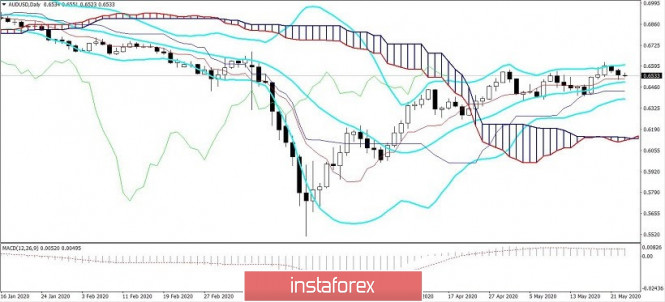The Australian dollar, coupled with the US currency, continues to trade within the narrow-range flat - having opened the week with a small downward gap at around 0.6534, The aussie closed it almost immediately. The AUD/USD pair rose to the price level of 0.6551 during the Asian session on Monday, but could not gain a foothold above, dropping into the area of the opening price.

If we consider the situation in a broader aspect, then we are now seeing a downward pullback after an unsuccessful test of the resistance level of 0.6600 (the upper line of the Bollinger Bands indicator on the daily chart). The aussie tried to gain a foothold in this price area last Wednesday, but, having failed, gradually began to slide down. However, it cannot be said that the bears are now in full control of the pair's situation: the downward dynamics looks uncertain, and is accompanied by upward impulses. But in general, bulls clearly lost the initiative amid the contradictory fundamental background. It is worth noting that the Australian dollar has been amazingly strong for quite some time - traders have virtually ignored Australia's key macroeconomic reports over the past few weeks, which reflected the negative effects of the epidemic and lockdown.
For example, the latest release of data on the growth of the Australian labor market went almost unnoticed - the pair formally decreased by several tens of points, after which it quickly recovered. Although the unemployment rate in the country rose to 6.2%, and the growth rate of the number of employees showed an anti-record: it plunged by almost 600,000. Full employment decreased by nearly 230,000, part-time by more than 370,000. The share of the economically active population fell to 63%. But, the Aussie practically did not suffer despite such a significant slowdown in the labor market, and a few days later resumed the upward trend.
The Reserve Bank of Australia was also unable to reverse the upward direction of the aussie, despite the controversial rhetoric of the regulator. The minutes of the last meeting, published last week, indicates that the central bank is ready to increase the volume of purchases of government bonds "if necessary." At the same time, RBA members voiced an extremely pessimistic medium-term forecast: according to their estimates, the country's GDP is expected to decrease by more than 10% in the first half of the year. The main blow of the crisis will be in the second quarter: in particular, unemployment should rise to its peak values, that is, to about 9-10%.

But market participants here decided that "the glass is still half full than empty", focusing on the positive aspects of the May meeting. First, the RBA announced that it was keeping a wait-and-see position amid rumors of expanding incentives. Secondly, the regulator, again contrary to rumors, announced a reduction in the volume and frequency of bond purchases. In addition, both the accompanying statement and the RBA's quarterly report indicate that the country's key economic indicators should recover in the second half of the year, and the pace of this recovery will depend, in particular, "on how long restrictive measures remain." At the same time, Australia began quarantining in early May, planning to complete this process by the end of July. Therefore, traders decided to "close their eyes" to the current economic downturn, focusing on forecasts of quick recovery. The aussie's additional support was provided by news from the front of the fight against coronavirus: US company Moderna reported its first significant successes on May 18 - specialists were able to produce antibodies in the tested people.
Nevertheless, despite such a "margin of safety", the aussie could not storm the 66th figure. The main reason is the growth of geopolitical tensions. US President Donald Trump continues to express dissatisfaction with China's reaction to the outbreak of coronavirus, while Beijing, first, rejects the charges against it, and secondly, accuses the United States of "spreading lies and attacks on the PRC." Washington's accusations sound tougher and tougher - for example, Trump's national security adviser Robert O'Brien recently compared China's actions after the outbreak of coronavirus with concealing the disaster at the Chernobyl nuclear power plant in 1986. Foreign Minister Wang Yi, in turn, said that the White House is pushing Beijing toward the start of a "new cold war."
Earlier, State Department chief Michael Pompeo accused China of concealing data on the spread of coronavirus, after which Senator Lindsay Graham introduced a bill allowing President Donald Trump to impose sanctions on China for refusing to cooperate in identifying the causes of the pandemic. In response to the introduction of this bill, Beijing threatened "retaliatory measures", without specifying, however, what exactly is being discussed.
Hong Kong is another "fault line". The United States has supported the anti-Chinese movement protest of the Hong Kong people throughout the past year, causing Beijing's logical irritation. Now, Beijing itself has acted as a kind of irritant in this matter. The fact is that the Parliament of China will consider the adoption of a new law on national security in Hong Kong this week. If approved, it will provide the Chinese authorities with enhanced opportunities to intervene in the affairs of the former British colony. This issue is included in the agenda of the session of the All-China Assembly of People's Representatives, which began on May 22 and will last until May 28. This initiative was opposed not only by the United States, but also by the European Union, Canada, Great Britain, and also Australia. However, according to some analysts, Beijing is very likely to adopt the bill, provoking retaliatory sanctions from Washington.
Thus, the growth of anti-risk sentiment in the foreign exchange market is justified. The Cold War between the United States and China will obviously slow down the process of restoring the global economy after the coronavirus crisis. And this scenario, apparently, is becoming increasingly believable.


The aggravation of the political conflict between the US and China will put additional pressure on the pair, as the US currency will be used as a protective asset. Inside the day, the pair mayThe pair could fall to the 0.6520 level (the lower border of the Kumo cloud on the 30-minute chart) within the day, and even lower to the bottom of the 65th figure. If we look at medium-term prospects, then a decline to the 0.6440 level is likely - this is the Kijun-sen line on the daily chart. In conclusion, it is worth noting that US trading floors are closed today - they are celebrating Memorial Day in the United States.
The aggravation of the political conflict between the US and China will put additional pressure on the pair. Meanwhile, another fault line appeared in the relationship between the superpowers.
The material has been provided by InstaForex Company - www.instaforex.com